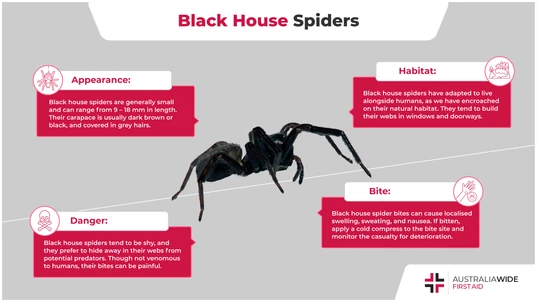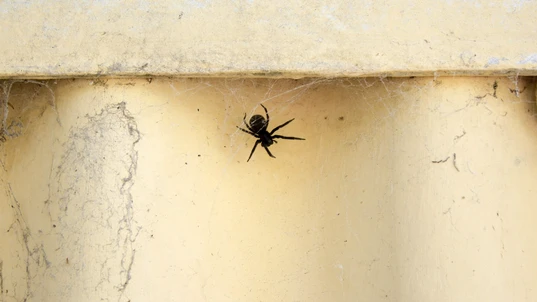Spider Facts: The Black House Spider

Bites and Stings

The Black house spider is an unexpected house guest in most Australian homes. Though they are generally timid in nature, and prefer to hang out in their web away from predators, Black house spider bites should not be underestimated.
Most commonly found in homes, Black house spiders are well-adapted urban dwellers. They have learnt to live alongside humans as our populations continue to spread into their natural habitats. However, despite their small size, Black house spiders are not to be underestimated. As with all wild animals, it is recommended that you regard these venomous critters with caution.Introduction
Black house spiders, also known as the common black spider or window spider, are native to Australia, though they have also been introduced to New Zealand and some areas of Japan. They are a common species of cribellate Australian spider and belong to the Desidae family. They are also closely related to the Badumna loginqua, the grey house spider. Black house spiders can be found in every territory, including Tasmania, though they are mainly found in southern and eastern Australia. Generally, the Black house spider can be found on rough-barked trees. However, due to human populations encroaching on their natural habitats, Black house spiders are now commonly found in corners of the home, as well as windows and doorways. Black house spiders prefer to live in locations where light sources are present, as these attract smaller insects that can be eaten as food. Giant black house spiders, meanwhile, have been reported to live in caves, dry forests, and under rocks. Their webs are normally funnel-shaped structures with crescent-shaped web entrances. Black house spiders also embed bark and other detritus into the silk to act as a disguise. These spiders are usually not aggressive. Females normally remain hidden away in their webs, while smaller males are often seen wandering around looking for mates during mating season, which begins in the summertime. Most Black house spiders live for approximately two years.Appearance
Black house spiders are generally small spiders. Females can grow up to 12 – 18 mm in length, whereas males only grow up to 9 – 15 mm in length. These spiders are dark in colour, and small grey hairs are usually visible on their carapace. The carapace itself, alongside the legs, are dark brown to black in colour, while the abdomen is often grey and covered in a variegated pattern of white markings. Here are some identifiers that are typical of the Black house spider:- The head and thorax of the spider is often black and rectangular at the front
- The abdomen is round and tends to be dark grey or velvety black in colour
- The body can grow up to 2 cm in length
- White markings on the abdomen may sometimes be indistinguishable
Hunting habits
True to their other common name, the Window spider, Black house spiders often build lacy webs in window corners. These webs are often messy and have cone or funnel-shaped tunnels at their centre. Black house spiders will often wait behind these tunnels to hide from potential predators or to await any unsuspecting prey that land on their sticky, silken web. If a prey does land on their web, the Black house spider will race up the tunnel to bite and seize the unfortunate critter. In the wild, the Black house spider can be found near rough-barked trees, as the bark cracks provide good shelter. They will position themselves near holes, injuries or openings made in the tree trunks by wood-boring insects to await butterflies, bees or ants that like to feed on the tree sap. These insects end up getting caught in the spider's lacy web and ultimately eaten. Spiders dwelling in the home instead prey on moths, beetles and termites - insects that are attracted to the light or lamps at night. When living in a home with a Black house spider, you will likely notice that there are less insects roaming around. This is because Black house spiders are very good at controlling insect populations. They are also an abundant food source for birds and other predators - in fact, they are the preferred food source of the White tail spider.Danger to humans
Despite being venomous, Black house spiders are not considered a threat to humans. These spiders are rather shy and timid, and they tend to hide away in their webs from any potential predators.
In the wild, Black house spiders prefer hanging out in rough-barked trees. However, as humans have encroached on their natural habitat, Black house spiders now like building their lacy webs in windows and doorways.
First aid
Despite their shy nature, Black house spiders can deliver excruciatingly painful bites. Their bites can also cause terrible reactions and symptoms, including:- Local swelling,
- Nausea,
- Vomiting,
- Sweating,
- Giddiness, and
- Skin lesions.
- Reassure the casualty and keep them under constant observation.
- Apply a cold compress to the bite site for periods of up to 20 minutes to lessen the pain.
- If the casualty is a young child (under 8 years), a pregnant woman, or if they exhibit any signs of deterioration, follow the basic life support guidelines per DRSABCD and call Triple Zero (000) for an ambulance.
- DO NOT use the Pressure Immobilisation Technique, as the venom moves slowly and this will just worsen the pain.
Anaphylaxis
Spider bites can trigger severe allergy symptoms, including breathing difficulties, facial swelling, and feelings light-headedness. If the casualty begins exhibiting signs of a severe allergic reaction, otherwise known as anaphylaxis, call Triple Zero (000) for an ambulance, consult the Australian Resuscitation Council's anaphylaxis treatment guideline, and follow DRSABCD and prepare to perform CPR.Looking to get you First Aid knowledge up to date?
We run certified First Aid courses throughout all major Acustralian citys. Find a location near you.
Fun facts
- Due to their abundance, Black house spiders are not on the International Union for Conservation of Nature’s Red List and can be found in most Australian homes
- People often mistake Black house spiders for Funnel-web spiders due to their funnel-shaped webs
- Black house spiders will add new layers onto their web during the night, which causes old webs to look grey and woolly from all the additional silk
- Black house spiders are solitary creatures
- Female spiders will lay eggs in a round shaped sack made from white silk
Final thoughts
While Black house spiders might seem light innocuous additions to the average Australian home, these arachnids are not to be underestimated. Though they are generally timid in nature and don't venture outside of their webs unnecessarily, Black house spiders have been known to deliver seriously painful bites. To equip yourself with the skills and knowledge to identify and treat a Black house spider bite, book a First Aid course with us today!Recommended resources
Our Resource Library is brimming with resources on how to identify and treat a wide variety of bites and stings. For instance, we have articles on what to do if you get stung or bitten by a snake, a fire ant, and different types of marine life. Our article on spider bites also does a deep dive on how to identify and treat bites from some of Australia's deadliest spiders, including the Wolf spider, the Huntsman spider, the White tail spider, and the Redback spider. Disclaimer: This article is for informational purposes only. It does not constitute, replace, or qualify as any form of first aid training.
Originally published at
https://www.australiawidefirstaid.com.au/resources/black-house-spider
as part of the Australia Wide First Aid Articles Library









